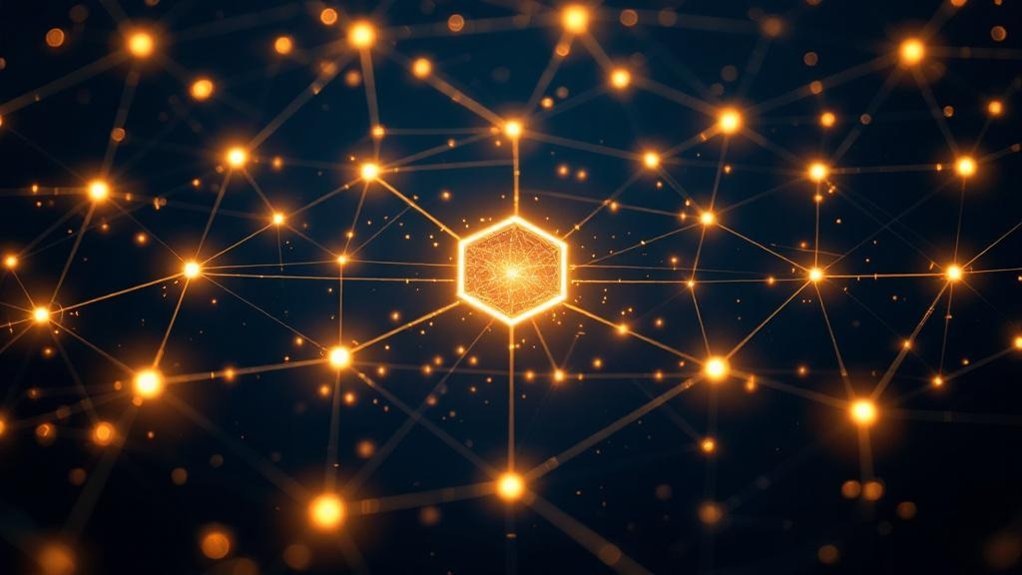MakerDAO revolutionized crypto by putting DAI stablecoin‘s fate in its community’s hands. Through MKR tokens, holders vote on everything from collateral types to system parameters – no suits in boardrooms needed. Smart contracts automatically manage collateral and maintain DAI’s dollar peg, while every transaction sits publicly on the blockchain. It’s finance democratized, automated, and transparent. The future of money isn’t controlled by banks – it’s controlled by code and community. There’s more to this DeFi pioneer‘s story.

While traditional finance keeps a tight grip on the reins, decentralized stablecoins are flipping the script on who calls the shots. MakerDAO stands at the forefront of this revolution, putting the power directly in the hands of its community. MKR tokens enable holders to participate in governance, making key decisions that affect the protocol’s future.
No suits in boardrooms here – just token holders who propose and vote on changes that shape the future of the DAI stablecoin. The peer-to-peer ecosystem eliminates the need for traditional banking intermediaries while maintaining financial functionality.
Power to the people: DAI puts control in token holders’ hands, not corporate boardrooms or profit-hungry executives.
The system’s genius lies in its simplicity. Token holders get voting power based on how much skin they’ve got in the game. Want more say? Hold more tokens. It’s that straightforward.
These stakeholders make the big calls on everything from collateralization ratios to liquidation parameters. And unlike traditional finance, there’s no smoke-filled backroom deals – every decision happens in broad daylight. The algorithmic mechanisms automatically stabilize DAI’s value by adjusting to market changes.
The nuts and bolts of DAI’s stability are equally transparent. Smart contracts automatically manage crypto collateral, maintaining DAI’s dollar peg through overcollateralization.
When markets get choppy and collateral values drop, liquidation kicks in faster than you can say “margin call.” The whole system runs like clockwork, adjusting supply based on market demands and maintaining solvency through automated protocols.
What really sets decentralized stablecoins apart is their radical transparency. Every transaction, every bit of collateral, every governance vote – it’s all there on the blockchain for anyone to see.
Try getting that level of transparency from a traditional bank. Smart contracts eliminate the middlemen, and users can audit everything in real-time. No more taking someone’s word for it.
This stands in stark contrast to centralized stablecoins like USDC and USDT, where companies hold all the cards – and the cash.
Decentralized stablecoins spread the control across their communities, making them more resilient to censorship and single points of failure. Anyone can participate in minting or governance without asking permission.
It’s finance democratized, automated, and transparent – exactly what cryptocurrency was meant to be in the first place.
Frequently Asked Questions
How Do Liquidations Work in Makerdao’s System?
MakerDAO’s liquidations kick in when a Vault’s collateral value drops below its required ratio.
Automated Keepers – the system’s watchdogs – spot these troubled Vaults and trigger collateral auctions. Bidders compete to buy the collateral with DAI, which gets burned. Only enough collateral is sold to cover the debt plus penalties. The rest? It goes back to the Vault owner. Pretty efficient system, actually.
What Happens if DAI Loses Its Peg to the US Dollar?
When DAI loses its dollar peg, chaos erupts.
Users face potential losses if they can’t redeem at $1, while massive liquidations can trigger forced asset sales.
The domino effect hits other DeFi platforms using DAI as collateral.
Market confidence takes a nosedive, sparking liquidation cascades.
Worse still, the entire ecosystem gets destabilized, potentially leading to wider crypto market contagion and increased regulatory scrutiny.
Can Anyone Participate in Makerdao Governance Without Holding MKR Tokens?
While anyone can lurk in forums and post suggestions, actual governance power? Nope.
You need MKR tokens to vote – period. Non-holders are limited to advisory roles, watching from the sidelines.
Sure, they can participate in discussions and provide feedback through community channels, but when it comes to making real decisions about MakerDAO’s future, no MKR means no vote.
Pretty straightforward stuff.
How Does Makerdao Handle Emergency Shutdowns?
MakerDAO’s emergency shutdown is a last-resort safety switch.
When triggered, it freezes the system, stops new Dai generation, and locks collateral prices.
Vault owners get first dibs on withdrawing excess collateral.
After a 73-hour cooldown, Dai holders can redeem their tokens for a proportional slice of all system collateral.
MKR holders control the shutdown through voting – basically pulling the plug when things get dicey.
What Role Do Oracles Play in the Makerdao Ecosystem?
Oracles are MakerDAO’s eyes and ears for real-world asset prices.
They feed vital price data into the system through a network of independent sources and validators. The process isn’t simple – price feeds get aggregated, checked, and delayed through security modules to prevent manipulation.
It’s basically impossible to run the protocol without them. They determine when vaults get liquidated and how much DAI users can mint against their collateral.
